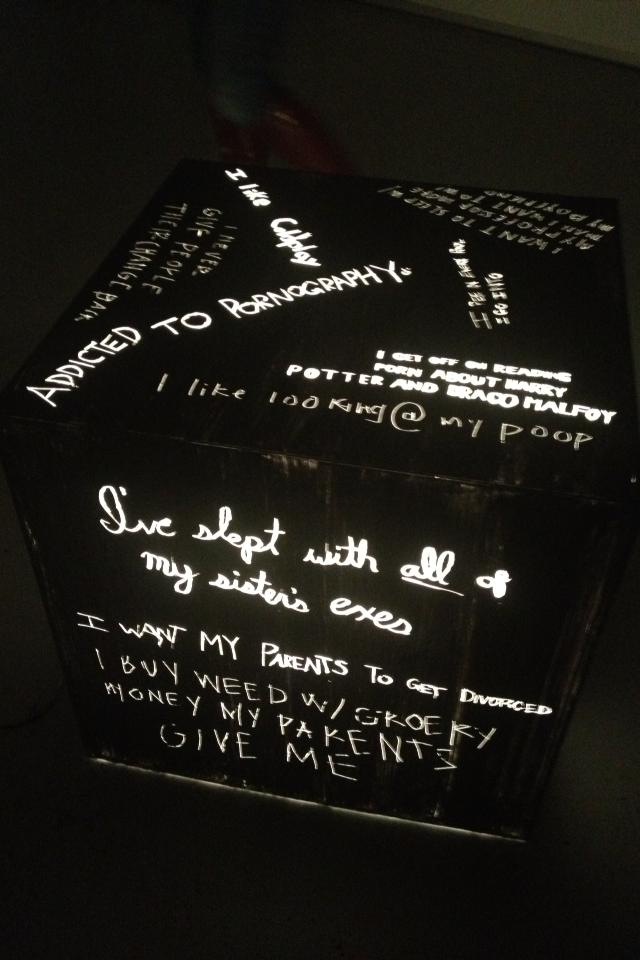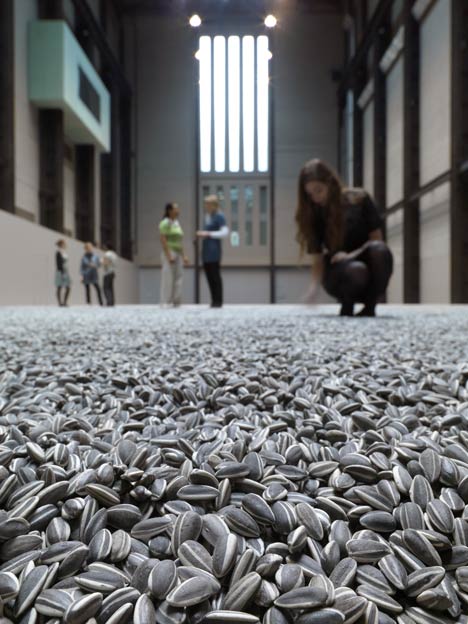"Trouble at the Interface or the Identity Crisis of Interactive Art"
Interactive art is a really cool idea because it has been drilled into our minds for so long that you cannot touch art. When you were a kid growing up and your parents took you to an art gallery or museum, the security would be watching you like a hawk just to make sure you were not touching, or even going too close, to any of the pieces. This new form of art enables, even invites, you to touch. Touching it actually becomes an art form in itself - It is almost like you are part of the art piece. Even now whenever I go into a gallery or museum and it says feel free to touch or something, I am still tentative about it because I am so not used to being allowed to tough art. This form of art is really pushing the boundaries in the art world. I actually did a piece last quarter for Art 22 that was an interactive piece. I made a series of boxes (3) out of plexiglas and painted them black. (pictured below, left) Then, I carved peoples secrets that I had accumulated from friends, family, friends of friends, into the box. I left a lot of room on the boxes so that during the art show, viewers were encouraged to scratch their own secrets into the box. At first, people were very tentative to scratch into the boxes because of course you feel weird about carving into somebody elses work, but later they were encouraged more when more and more people started doing it. I really love working with interactive art. There is an artist named Ai Wei Wei that made a piece called 100 million Sunflower Seeds, where he and a group of people hand made 100 million sunflower seeds and displayed them on the ground, where the audience was encouraged to walk all over them and scuff them up. (pictured below, right) People were tentative at first because its not that often that you are invited to walk on art. I think the human interaction adding to the piece is a really cool element, like we are all artists to the piece.


"Database as Symbolic Form"
One really cool point in this article is when the writer describes the web as medium, as in a site can be a work of art. This hits home to me and is really eye-opening because before I took this class I so took websites and website building, for granted, not realizing how intricate and complicated it is. Now that I am in this class, I have utmost respect for websites and website designers. Websites really are an art form, which is amazing to think about when you think about the fact that websites are under the same category art as Renaissance paintings and Jackson Pollock. People, I was guilty of this myself, do not usually consider web pages art, but when you really think about it, they are.
Excerpt from "The Society of Mind"
I thought this article was really interesting. It talks all about how a piece can work in a way that’s not obvious to the viewer, which really made me think a lot. The analogy used in this piece is that everything is made up of fundamental building blocks but you cannot necessarily explain how this happens. Minds are composed of processes, instead of blocks. Our minds have changed so much as humans as we grow up - something as fascinating as building blocks when we were little is now a mundane activity because we are so much more experienced now. We all know how to build blocks, but we do not understand how we learn to do them because these are skills we learned so long ago and so early on that we do not even remember learning them. We all take these skills for granted and do not really think about how they even began - this is interesting to think about, like we were born with these simple skills but we actually were not. We were born clean slates and we learned these skills, but we learned them so early on we do not even know when or how we learned them and we could never imagine a life where we did not know how to do these things. Common sense is a funny thing because some people have a lot of it and some people do not have as much - it is kind of a crazy thing. What makes someone have more common sense than another? Where did they learn this? Do you learn common sense? Does it depend on how intelligent you are? How you were raised? There are a lot of questions. Another part of the reading that interested me is when the writer compared people to machines, because honestly I guess if you think about it, we really are a type of complex machine. People assume machine means something mechanical but the human body and mind is a complex machine in itself. This kind of reminds me of Graham Budgett and Jane Mulfingers piece where they kind of brought two machines - human and mechanical - together into one public art piece. They had people write into a computer their biggest regret and when it was typed out, the words would be projected onto a building, so their anonymous regrets were displayed in huge fonts, scrolling up, down, left, right, across the side of a building. This reminded me of the combination of interactions between humans and machines.
Art 7D smaller video from lucy reyer on Vimeo.